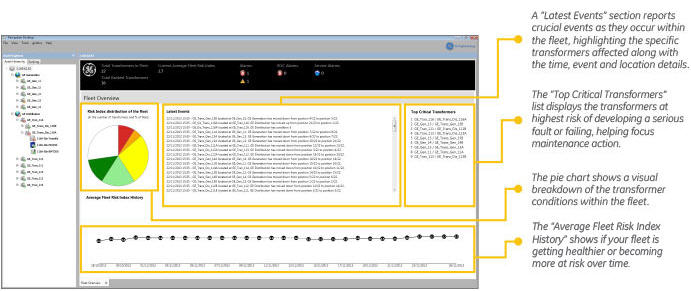GE Perception Fleet
GE's Perception Fleet is a smart, simplified and standards-based software system that moves customers from a manual, one-on-one transformer assessment process to an automated and online fleet management assessment. By automatically evaluating the condition of assets and establishing their risk of failure, Perception Fleet is able to prioritize and rank assets within a fleet. The Perception Fleet software provides customers comprehensive transformer fleet condition rankings, transformer risk information, and expert analysis on-demand, removing time-consuming and costly manual processes as well as unnecessary maintenance, helping focus capital and reduce operational expenses.
Key Benefits
Transformer Fleet Replacement Strategy- Provides a clear strategic view for asset replacement across the entire fleet
- Tracks the fleet risk index over time to show the improving overall condition of the fleet
- Allows for flexible and scalable transformer fleet risk management
- Provides the insight required to shift from costly time-based maintenance to cost effective and focused condition-based maintenance
- Reduces ambiguity and the need to speculate regarding budget requirements
- Reduces OPEX usage on assets to only as required
- Reduces time required to gather, amalgamate, analyze and interpret transformer diagnostic data
- Provides intelligent algorithms to determine each transformer's condition, and ranks the transformers in the fleet based on their risks
- Reduces reliance on transformer expertise that is rapidly being lost
Standards-Based Management
The algorithms used in Perception Fleet automatically apply these standards along with best practice techniques against the dissolved gas data received by the GE online monitoring device. By combining these standards within the algorithms, the software is able to calculate the transformers risk index and score. The algorithm assigned to a transformer can also be weighted in terms of its importance and its sensitive to the parameters adjusted - these adjustments have a direct impact on the algorithm and affects the final risk index and risk score applied to each transformer. Perception Fleet's standards-based algorithms Include: CIGRÉ TB 227: provides five (5) transformer conditions in terms of its reliable operation. Using this information we are able to tailor the standards used within the Perception Fleet algorithms to determine 5 transformer risk index conditions.IEEE C57.104: describes four (4) condition levels for absolute dissolved gas concentration. To increase accuracy and provide a broader scope, GE rebuilt the condition limits and set five (5) condition levels using information from CIGRÉ TB 227. By individual assigning each gas its condition level limits and triggers, we factor in the potential risk associated with the concentrations of certain gases over others.
IEC 60599 (1999): provides the dissolved gas rate of change expectance for normally operating transformers.
IEC 60422 (2013): used to analyze moisture in oil providing three (3) levels of H2O concentration. To increase accuracy and provide a broader scope, GE rebuilt the condition limits and set four (4) condition levels based on information from CIGRÉ TB 227.
EPRI Ratios: Provides details on gas concentration ratio characteristics, used to analyse OLTC insulation oil.
Web Interface
Perception Web can be configured to run as an Intranet or Internet service. The Internet configuration allows users to access and browse the Perception Web data from anywhere on a device with an Internet connection securely. When configured for Intranet access users must be connected to their organisations network infrastructure directly or via a VPN.
